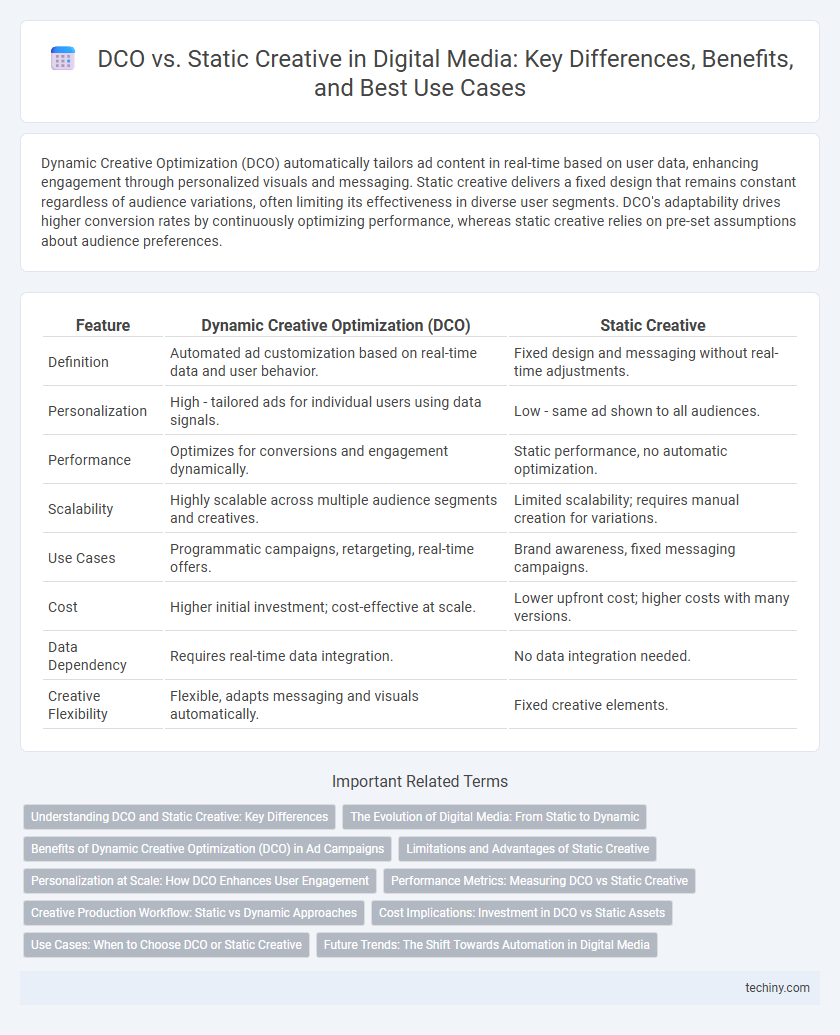Dynamic Creative Optimization (DCO) automatically tailors ad content in real-time based on user data, enhancing engagement through personalized visuals and messaging. Static creative delivers a fixed design that remains constant regardless of audience variations, often limiting its effectiveness in diverse user segments. DCO's adaptability drives higher conversion rates by continuously optimizing performance, whereas static creative relies on pre-set assumptions about audience preferences.
Table of Comparison
| Feature | Dynamic Creative Optimization (DCO) | Static Creative |
|---|---|---|
| Definition | Automated ad customization based on real-time data and user behavior. | Fixed design and messaging without real-time adjustments. |
| Personalization | High - tailored ads for individual users using data signals. | Low - same ad shown to all audiences. |
| Performance | Optimizes for conversions and engagement dynamically. | Static performance, no automatic optimization. |
| Scalability | Highly scalable across multiple audience segments and creatives. | Limited scalability; requires manual creation for variations. |
| Use Cases | Programmatic campaigns, retargeting, real-time offers. | Brand awareness, fixed messaging campaigns. |
| Cost | Higher initial investment; cost-effective at scale. | Lower upfront cost; higher costs with many versions. |
| Data Dependency | Requires real-time data integration. | No data integration needed. |
| Creative Flexibility | Flexible, adapts messaging and visuals automatically. | Fixed creative elements. |
Understanding DCO and Static Creative: Key Differences
Dynamic Creative Optimization (DCO) uses real-time data to personalize ads, enhancing engagement through tailored messaging and visuals, unlike static creative which remains unchanged across all impressions. Static creative offers a fixed design focusing on brand consistency but lacks the flexibility to adapt to audience behavior or contextual variables. DCO's ability to optimize and automate creative elements drives higher conversion rates, making it ideal for campaigns requiring precise targeting and responsiveness.
The Evolution of Digital Media: From Static to Dynamic
Dynamic Creative Optimization (DCO) revolutionizes digital media by replacing static creatives with personalized, data-driven ads that adapt in real-time to user behavior and context. Unlike static creatives, which display fixed messages, DCO leverages algorithms and audience insights to increase engagement and conversion rates through tailored content. This evolution reflects the industry's shift towards more efficient, targeted advertising strategies that maximize ROI and enhance user experience.
Benefits of Dynamic Creative Optimization (DCO) in Ad Campaigns
Dynamic Creative Optimization (DCO) leverages real-time data to tailor ad content, enhancing relevance and engagement compared to static creative ads. By automatically adjusting visuals, messaging, and offers based on audience behavior and preferences, DCO increases click-through rates and conversion metrics. This data-driven personalization optimizes ad spend efficiency and drives higher ROI in digital media campaigns.
Limitations and Advantages of Static Creative
Static creative offers simplicity and consistency in digital media campaigns, making it easy to produce and ensuring brand message uniformity across all placements. Limitations include a lack of personalization and adaptability, which can result in lower engagement compared to Dynamic Creative Optimization (DCO) that delivers tailored content based on user data. Static creatives also have reduced flexibility in real-time optimization, restricting their effectiveness in targeted audience interactions.
Personalization at Scale: How DCO Enhances User Engagement
Dynamic Creative Optimization (DCO) leverages data-driven algorithms to personalize ad content in real time, significantly enhancing user engagement compared to static creative. By tailoring visuals, messages, and offers to individual user preferences and behaviors at scale, DCO delivers more relevant experiences that increase click-through rates and conversion performance. Brands utilizing DCO benefit from improved ROI through dynamic adaptation, whereas static creatives remain fixed and less responsive to audience variations.
Performance Metrics: Measuring DCO vs Static Creative
Dynamic Creative Optimization (DCO) outperforms static creative by increasing click-through rates (CTR) and conversion rates through real-time personalization based on user data. Performance metrics for DCO include enhanced engagement, reduced cost per acquisition (CPA), and higher return on ad spend (ROAS) compared to static creatives, which rely on fixed visuals and messaging. Analytics tracking tools reveal that DCO campaigns generate more impressions and audience interactions, leading to superior overall campaign effectiveness.
Creative Production Workflow: Static vs Dynamic Approaches
Dynamic Creative Optimization (DCO) streamlines creative production by enabling real-time customization based on audience data, significantly reducing the need for multiple static asset versions. Static creative workflows rely on fixed designs that require manual updates for each variation, leading to longer production cycles and higher resource demands. Integrating DCO into advertising strategies accelerates campaign deployment, enhances personalization, and improves overall efficiency in digital media production.
Cost Implications: Investment in DCO vs Static Assets
Dynamic Creative Optimization (DCO) involves higher upfront investment due to the development of adaptive assets and data integration, whereas static creative requires lower initial costs with fixed designs. Over time, DCO reduces costs by automating personalization and improving campaign efficiency, leading to better ROI compared to the repetitive expense of creating multiple static versions. Brands leveraging DCO experience cost savings through real-time optimization and minimized manual asset production.
Use Cases: When to Choose DCO or Static Creative
DCO (Dynamic Creative Optimization) excels in campaigns requiring real-time personalization, such as retargeting and programmatic ads where user behavior data drives creative variation. Static creative remains effective for brand consistency in broad-reach campaigns or when messaging simplicity and quick production turnaround are priorities. Selecting DCO or static creative depends on the campaign's need for adaptability, targeting precision, and resource availability.
Future Trends: The Shift Towards Automation in Digital Media
Dynamic Creative Optimization (DCO) is rapidly surpassing Static Creative in digital media through its ability to deliver personalized, real-time ads tailored to audience behavior and preferences. Future trends indicate a strong shift towards automation, leveraging AI and machine learning algorithms to optimize ad performance, reduce manual intervention, and enhance user engagement. This evolution in digital advertising is driving higher conversion rates and improved ROI by dynamically adjusting creative elements based on data-driven insights.
DCO vs Static Creative Infographic

 techiny.com
techiny.com